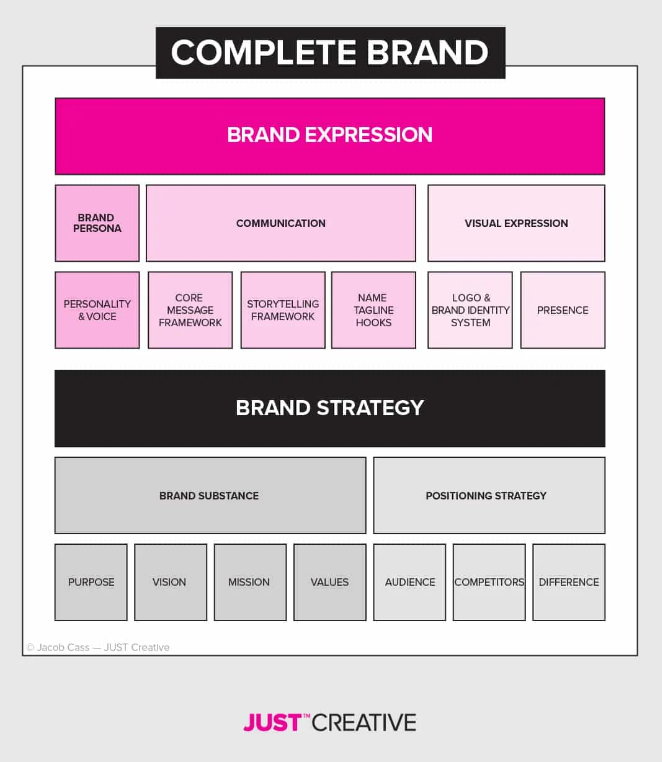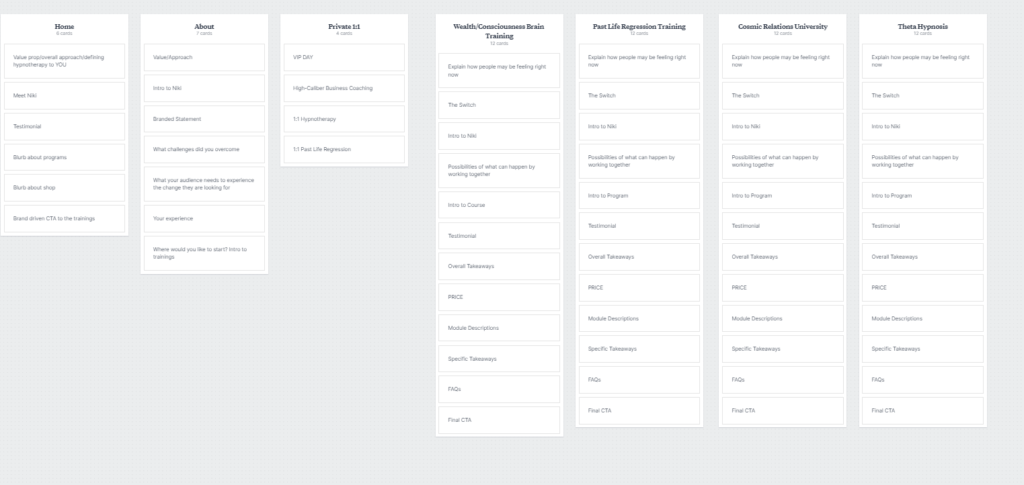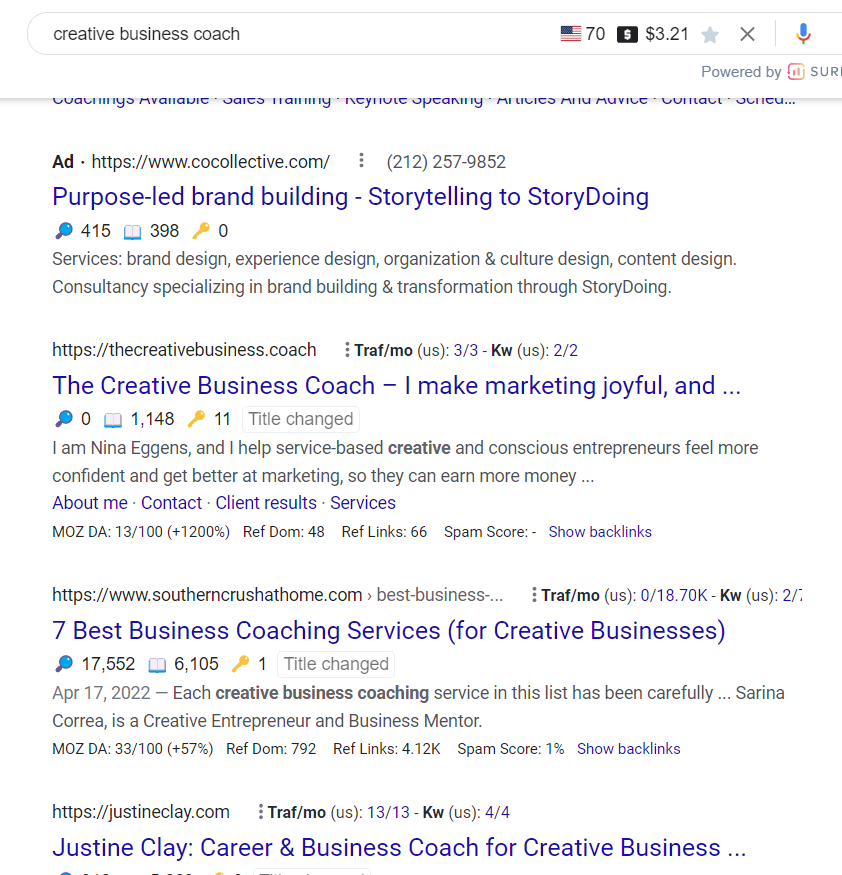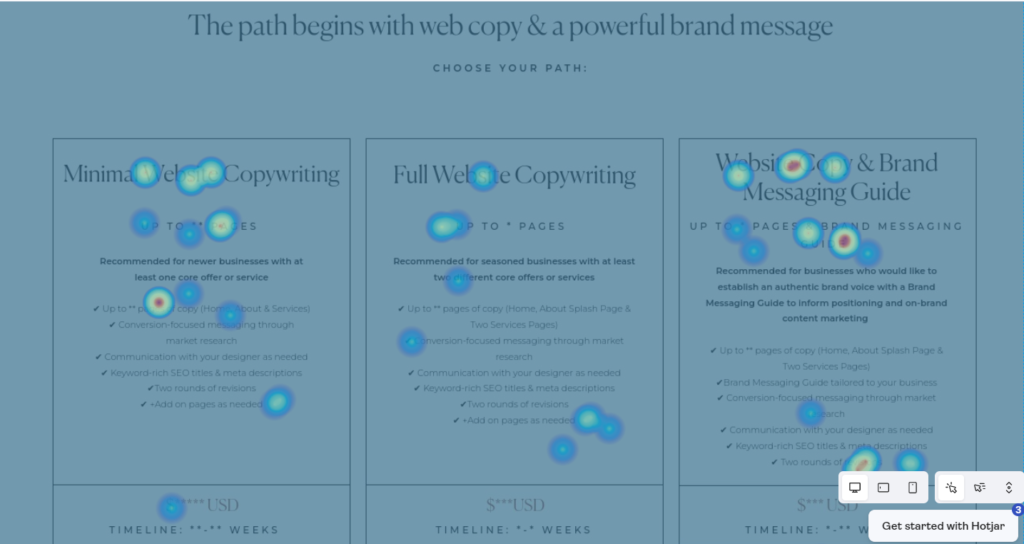Your website (therefore your website’s web copy) is your business’ #1 online asset because it’s the only place on the internet that solely belongs to you. Not to mention, it’s one of the few places that directly puts dollars in your bank account.
You know, the green stuff we need to keep the lights on as small business owners.
This means at a certain point in business, you can’t afford to “wing it” when it comes to your web copy. It’s the only barrier between you and a sale. Meaning, when someone visits your site, they should be just a few clicks away from taking the next step with you — with confidence.
The “next step” could be inquiring about your services, buying your course, signing up for a waitlist, joining your newsletter — you get the idea. Whatever it is that gets a customer in your sales funnel.
Well, with all this heightened pressure surrounding your site, what’s the difference between web copy that is effective vs. web copy that’s just whomp-whomp?
Let’s break it down.
Brand Messaging & Compelling Brand Voice
What does branding have to do with copywriting? The answer is… pretty much everything.
Check it out:

There are two sides to your brand — Brand Strategy and Brand Expression. We’ll start with Brand Strategy on the bottom half first.
Everything within your Brand Strategy: your purpose, vision, mission, values, audience, competitors, and differentiators are allllll explained with words. And in case I need to be more specific here, copywriting.
To create a brand, you don’t start with the pretty stuff and work backward. You determine phrases and written ideas that describe your Brand Substance and Positioning Strategy first. It’s what drives the brand as a whole.
Then, once you’ve worked through the foundational work, you can finally get to what’s called Brand Expression, which is the top half of the chart.
Yet again, you’ll find word choice plays a huge role in Brand Expression. See where it says “Brand Persona and Communication”? Pretend those two sections combined said “Brand Messaging” because basically, they mean the same exact thing.
Under Brand Persona and Communication, you’ll see personality & brand voice, core messaging framework, storytelling framework, and name/tagline/hooks. This all has to do with how your brand communicates.
Remember how I said your website is your #1 online asset? It’s also the embodiment of your brand.
Therefore, your website copy needs to ensure first and foremost, that it expresses the substance, positioning, persona, and communication style of your brand.
This is everything.
It’s what sets you apart from other brands exactly like yours and will make customers excited to invest in YOU vs. the competition out there.
Voice of Customer Market Research
This is the element MOST businesses will immediately skip and it’s a HUGE detriment to the effectiveness of their web copy.
If you’re new to the whole copywriting thing, let me share a definition I really like from CopyBlogger:
“Copywriting is the art and science of strategically delivering words (whether written or spoken) that get people to take some form of action.”
Copyblogger
We’re collecting valuable data from a set of people who MOST determine the success of your business: your audience.
Now that we’re on the subject of grade school, my 8th Grade U.S. History teacher used to say, “When you assume, it makes an a** out of you and me” (asterisks because although we like to keep it PG around here, Mr. Hilliard knew what he was talking about! ☺️.)
School references aside, the point is, we can’t ASSUME how our audience is feeling or what they need.
The core details I like to look for when doing market research for my clients are:
Pain Points — What is the problem your client is trying to solve by coming to you?
You’d be surprised that it probably goes deeper than just needing your service/what you sell.
They might have spent money on other options, perhaps even doing things on their own before coming to you.
They might have hired out similar businesses to yours before deciding to try you out.
Or, they just don’t have the time to try to do it on their own and would rather get it right the first time.
^This barely scratches the surface.
Regardless, we need to know your audience’s pain points.
Desires — What is the result or life-altering outcome your audience desires to experience after working with you?
People want to avoid pain at all costs. Duh. But the next highest need on a human’s list after avoiding pain is seeking pleasure.
I’m sure I don’t need to remind you about Netflix, do I? A marathon binge is the ultimate guilty pleasure we’ve all participated in at some point.
See, your audience could care less about your actual product or service. What they are ultimately looking for is how YOU can make their life better.
You’ve probably heard the saying “people don’t buy products/services, they buy transformations” and that’s absolutely true.
I mean think about it.
The last time you bought a mattress, for example, wasn’t just for the mattress. You just wanted to get a better night’s sleep — as you should.
Now take that analogy and run it through the filter of your business Potential clients and customers really want the transformation behind what you do.
When your web copy articulates this transformation with depth and specificity, the message is much more effective.
More importantly, readers will feel like you actually “get” them.
Objections + Anxieties — What holds them back from making a purchase?
OBJECTION!!

Sometimes that’s how it can feel when potential clients and customers come pounding through the door with hesitations about investing in you.
Don’t get offended though. Including authentic concerns your audience is thinking about in your web copy actually boosts credibility.
To put things in perspective, how would you feel if someone was pushing so hard for the sale, they dismissed all your legitimate questions?
The answer: NOT good 🙂
If you’ve had any experience with small callers or neighborhood soliciting, the answer is NOT good.
Oftentimes, objections have nothing to do with you. It has everything to do with their previous experiences.
Even more reason why this should be gathered from market research.
Word Pictures — The exact words your audience says that catch your attention
Word-who? Word-what? Word pictures!
Most business owners are so in the weeds, that at a certain point, they run out of creative ways to talk about themselves.
As you likely know, we’ve got to market 24/7. So how can you blame us for using the same phrases over and over again?
Your audience, however, is a vault of pure gold when it comes to creative words that describe your business.
They aren’t thinking about your business 24/7. And even better, they have some pretty clever ways of describing exactly how you help people.
So then, what IS a word picture? Here’s a snip from a lead-turned-client’s testimonial:
“If it were up to me, I’d be staring at a blank page still”
Notice how you can actually ENVISION someone staring at a blank page? Verses a phrase like “I didn’t know what to say”? Use more word pictures, or at least START using word pictures throughout your web copy — then watch how readers will be automatically impressed by what you do.
A Site Map Strategy
Here’s the thing: HALF the battle of effective website copy is knowing WHAT to say and WHERE to say it.
This quote from Eugene Schwartz helps to sum up the picture:
Copy isn’t written. It’s assembled.
Eugene Schwartz
Clever words mean nothing if they are organized in a confusing way.
SO there’s this handy dandy tool copywriters use all.the.time called a “site map”.
It’s a fancy word for the “map” we follow to make sure a website, includes every necessary page and must-have pieces of information. Here’s a quick example of one I pulled from a recent client of mine:

Site Maps are created by a combination of conversion-best practices (conversion being what it takes to make someone more likely to buy) AND your offer suite (offers suite being the services/products you sell that make you money).
Every business is different. Which means every site map will inevitably be different, too.
The trick is to narrow down the goal of your website, then from there, determine what pages and what information your website needs to REACH that goal.
When creating a site map, you want to ask yourself, what is the goal of your website? Is it to get more clients? More donations? More purchases?
And after that, you’ll need to ask yourself, “what information does my website need on each page to make it an easy yes for someone to take those actions?
SEO Strategy
Fun fact, as a conversion copywriter, my primary goal is making sure the copy on your website is written to convert the sale.
However, it doesn’t change the fact that SEO is a huge factor to consider when writing your web copy.
While conversion copy helps you make the sale, SEO strategy gets eyes on your website in the first place (via Google)
And when it comes to your SEO, the two best times to start implementing it are either yesterday or today.
There is a TON of SEO know-how that will likely confuse you if you do too much digging. So if you want your web copy to be SEO-friendly starting yesterday, you definitely want to start with these three components:
Keywords
Keywords are the words and phrases typed in the Google search bar when someone is searching for something they want.
Choosing the right keywords, much like copywriting, is both an art and a science.
On the “science” side, you want to pick target keywords that your customers are actually searching for related to what you offer.
Sounds simple enough, but identifying the right keywords can be tricky. A good rule of thumb is a keyword with high search volume, low competition, and words people are actually searching for it every month.
And by the way, once you’ve gathered a list, you want EACH page of your website to be optimized for one keyword.
Once you have those keywords, where do you put them?
Title Tags & Meta Descriptions
If you search for “creative business coach” (or literally anything) Google, you come to a page that looks like this:

After you glaze over the ads and NOT click them — because really, no one ever clicks on the ads — you’ll find your first few Google search results.
The blue headline is your “Title Tag”. An easy way to remember is that it’s the “title” of your search query. The 2-3 sentence blurb underneath is your meta description
These are prime real estate for your keywords.
Squeeze a keyword in your URL, you get bonus points!
Headlines, Subheadlines, and Body Copy
The next and THE most important place to put your keywords are within your headlines, subheadlines, and body copy.
This gives Google an opportunity to “crawl” your page and make sure the content on your site matches all the other websites with the same keyword.
On-Going Optimization
At this point, you may be thinking okay, great but what happens after I get all this stuff set up on my website?
And I know — getting a website up and running in itself is a challenge. But there’s no use in having a website if you don’t continue to optimize it!
Contrary to what you may think, your website is a living, breathing thing. The last thing you want to do is have a “set it and forget it” mentality.
Because the last time I checked, your business is evolving constantly. Which means your website should too.
The ability to optimize your website (in other words, make it perform better) as time goes on makes it worth having your website in the first place.
Here are just a few ways you can gather data to better:
Heat Maps & Click Maps
Hot Jar is great for seeing how far down the page your website viewer is going. It helps you see how compelling your web copy is to keep people moving down, and the first places to optimize copy.

Click Maps are also SUPER helpful to see where people are (and aren’t) clicking so you can optimize your calls to action.

Google Analytics + Google Search Console
You should be in both of these places at least once a month. The top things I like to look at for my own site and for my clients’ sites are:
- Traffic — How has it changed since your last rebrand or website update? Has it gone up?
- Audience — Where is traffic coming from the most? How can we optimize our presence there?
- Ranking keywords and domain authority — are you ranking for the keywords you want?
- Page views – Which pages are being viewed the most? How can we optimize them?
I’ve created a quick Loom video for you to make sure both are set up via a Showit Site.
Leads and Bookings
On average, you want to know how many leads or “conversions” you’re getting per month.
My Dubsado CRM makes it super easy to see where my leads are coming from and how many I’ve booked per month.
If you divide your conversions by the number of page views that the page is receiving, you’ll get your average conversion rate!
Gathering this data helps you be in competition with yourself. You’ll know exactly what actions you need to take and HOW to update your site to optimize for more traffic and more sales. Nothing better than that!
Effective website copy happens to be my jam
If you’re thinking about a website rebrand and thinking about outsourcing your web copy, fill out my inquiry form here. I love to not only hear from small business owners learning more about web copy but would love to help you understand how it will continue to serve your business once you have the foundations set. I’ve got an eye on my inbox whenever you’re ready. 🙂
free download!
5 Tips to Instantly Improve Your Website Copy in An Afternoon
Action-packed methods so your website can spark connections swiftly. Around the same time it takes to finish a leisurely afternoon stroll with a good friend — we should really do those more often.
